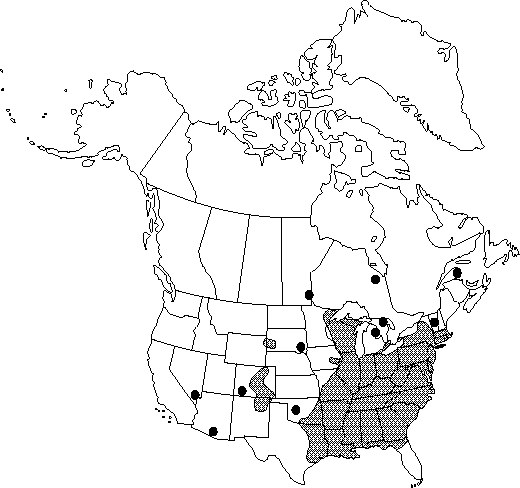Thalictrum amphibolum
Syst. Nat. 1: 173. 1817, not T. revolutum Le Lièvre 1873.
Stems erect, coarse, 50-150 cm. Leaves cauline, proximal leaves petiolate, distal sessile; petioles and rachises stipitate-glandular to glabrous. Leaf blade 1-4×-ternately compound; leaflets grayish or brownish green or dark to bright green, lanceolate, elliptic, ovate, reniform to obovate, apically undivided or 2-3(-5)-lobed, 9-60 × 5-50 mm, length 0.9-2.7(-5.25) times width, usually leathery, margins often revolute, lobe margins entire; surfaces abaxially with sessile to stalked glands or muriculate to whitish papillose. Inflorescences racemes to panicles, elongate, many flowered; peduncles and pedicels sometimes stipitate-glandular. Flowers usually unisexual, staminate and pistillate on different plants; sepals 4(-6), whitish, ovate to oblanceolate, (2-)3-4 mm; filaments white, slightly clavate, 2.5-7.8 mm, ± flexible; anthers (0.7-)1.2-2.7(-3) mm, blunt to apiculate. Achenes 8-16, sessile or slightly stipitate; stipe 0.2-1.7 mm; body lanceolate to ellipsoid, 3.5-5 mm, prominently veined, usually stipitate-glandular; beak ± persistent, linear-filiform, (1-)1.5-3.3(-5) mm, ± equal to length of achene body. 2n = 140.
Phenology: Flowering spring–summer (Mar–Jul).
Habitat: Dry open woods, brushy banks, thickets, barrens, and prairies
Elevation: 30-2000 m
Distribution

Man., Ont., Que., Ala., Ariz., Ark., Colo., Conn., Del., D.C., Fla., Ga., Ill., Ind., Iowa, Ky., La., Md., Mass., Mich., Minn., Miss., Mo., Nev., N.J., N.Mex., N.Y., N.C., Ohio, Okla., Pa., R.I., S.C., S.Dak., Tenn., Tex., Vt., Va., W.Va., Wis., Wyo.
Discussion
Glandular individuals of Thalictrum revolutum have been called var. glandulosior. They are seen throughout the range of the species and do not represent a distinct lineage. Occasional glandular plants with unusually short anthers are often misidentified as T. pubescens.
Material of this species from the western United States has been incorrectly assumed by previous authors to be T. dasycarpum, because T. revolutum is not included in floras of that region.
Selected References
None.